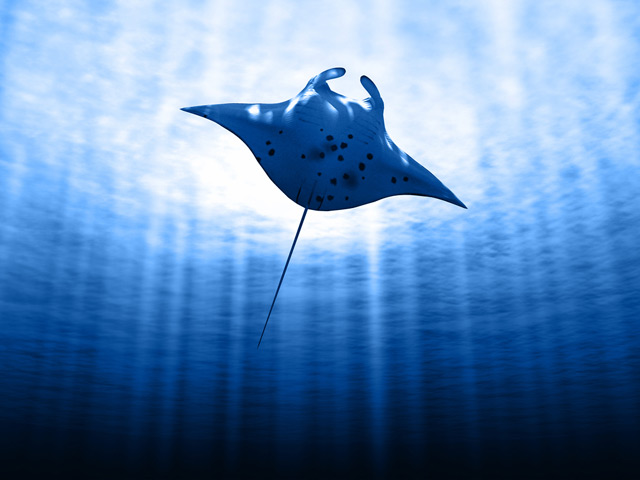Whale sharks, manta rays, hammerhead sharks…if megafauna floats your boat January is a great time to go diving.
Go to
1. Manta Madness in the Maldives
January is a great time of year to visit the Maldives, as the dry season brings long sunny days just perfect for relaxed Maldives liveaboard diving. Whilst each of the different atolls have their own characteristic dive sites and marine life highlights, there are plenty of manta rays to see wherever you choose to dive.
 Image: DepositPhotos
Image: DepositPhotosRasdhoo Atoll
This atoll may be tiny, consisting of just 4 islands and 3 sandbanks, but Rasdhoo Atoll scuba diving has a big reputation for large pelagics. Madifaru has almost every type of Maldives marine life on offer; including mantas, grey reef sharks, scalloped hammerheads, schools of eagle rays, mobula rays, stingrays, turtles and more. Manta Block is a great dive site for manta sightings at cleaning stations.
When you’ve had your fill of manta encounters, don’t miss out on diving Hammerhead Point for the chance to swim with hammerhead sharks.
Ari Atoll
January to April is a great time to go scuba diving in Ari Atoll and enjoy dry days and calm seas cruising among over 100 stunning islands, plus diving with mantas and whale sharks.
Kudarah Thila and Rangali Madivaru in the south host cleaning stations with numerous mantas. There are also great manta dive sites in other parts of Ari Atoll, including the premier Ukulhas Thila cleaning station in the north and Donkalo Thila in the west. The sheer variety of cleaning stations throughout this atoll make it ideal for manta ray encounters.
The Blue Voyager visits the far north atolls, deep south and the best sites at Rasdhoo, Ari and Male atolls. Their Pelagic Encounters safaris are always a popular choice at this time of year.
2. Best Time for Whale Watching in Mexico
Only accessible by Socorro Islands liveaboard diving, these remote and wild islands are one to add to your wish list for 2019. Humpback whales arrive in their thousands during January, giving you the chance to see and hear them underwater.

This archipelago also attracts huge amounts of other big pelagics, including at least ten species of sharks and the renowned friendly Giant Pacific manta rays found there. It is understandably known as the ‘Galapagos of Mexico’.
There is a handful of Socorro Islands liveaboards to choose from and the Quino el Guardian is a great choice for less experienced divers, as there is no minimum logged dives requirement.
Another gentle giant can be found if you go Sea of Cortez liveaboard diving at this time of year. A large whale shark population frequents the Bay of La Paz in Baja California Sur from early winter to late spring. Scuba diving is not allowed, but free diving and snorkelling are a great way to immerse yourself in the experience, without the weight of tanks and gear. Winter is also the best time to spot grey whales, mobula rays and humpback whales in the area.
The El Duque liveaboard offers 2-night getaways to the Sea of Cortez, whilst the Valentina has 6-night Sea of Cortez safaris for those who want to spend longer there.
3. Dive with Whale Sharks in Djibouti
Djibouti liveaboard diving might not be on your radar yet but it soon will be. This relatively new dive destination has pristine coral reefs with large schools of Red Sea and Indian Ocean fish. It is tucked away from the crowds of Egypt and gives you the chance to enjoy peaceful dive sites. The star attraction is of course the numerous whale sharks that gather in Djibouti’s waters from November to January.
Visit Djibouti in January and you can swim in the company of juvenile whale sharks and possibly also see manta rays, grey reef sharks and nurse sharks. There are striking underwater landscapes to explore, including a dive site that allows you to descend between three tectonic plates; aptly named ‘The Crack’. It won’t be long before word gets out about this top new dive destination.
The beautiful MSY ELegante liveaboard offers whale shark safaris and the chance to sail the turquoise waters of Djibouti from November to January each year.
4. Darwin Island, Galapagos – Hammerheads in the warm season
Darwin Island is what remains of an extinct volcano. It is 160 km northwest of the main Galapagos islands: reached by liveaboard. An upwelling of nutrient-rich cold water makes for a plethora of sharks, rays, turtles and other large, pelagic, species. One kilometre from Darwin Island was Darwin Arch, which collapsed in May 2021.
Darwin and Wolf islands experience a warm season from January to June and a cool season from July to December. Animals like hammerhead sharks frequently move between the islands, which are 40 km apart, especially in January when they are at their most frequent.
 Image: DepositPhotos
Image: DepositPhotosScientists from the Charles Darwin Research Station (CDRS) and the National Geographic Society have shown that Darwin and Wolf islands are home to the largest shark biomass on the planet.
The diving at Wolf and Darwin islands is fantastic – but you need to be an experienced diver. Currents can be strong and the swell significant. Even in the warm season water temperatures might still be as low as 21 oC (although they could be up at 27 oC). Take a hood and gloves.
Main image depositphotos.com
by the Divers and Writers of Liveaboard.com. Additional material Jill Studholme.
Image credits:
- manta-ray-below: DepositPhotos
- hammerhead sharks: DepositPhotos


















